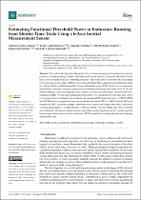Por favor, use este identificador para citar o enlazar este ítem:
https://repositorio.usj.es/handle/123456789/462
Registro completo de metadatos
| Campo DC | Valor | Lengua/Idioma |
|---|---|---|
| dc.contributor.author | Cartón-Llorente, Antonio | - |
| dc.contributor.author | García-Pinillos, Felipe | - |
| dc.contributor.author | Royo-Borruel, Jorge | - |
| dc.contributor.author | Jaén-Carrillo, Diego | - |
| dc.contributor.author | Roche-Seruendo, Luis Enrique | - |
| dc.contributor.author | Rubio Peirotén, Alberto | - |
| dc.date.accessioned | 2021-02-11T12:25:58Z | - |
| dc.date.available | 2021-02-11T12:25:58Z | - |
| dc.date.issued | 2021-01-15 | - |
| dc.identifier.citation | Cartón-Llorente, A.; García-Pinillos, F.; Royo-Borruel, J.; Rubio-Peirotén, A.; Jaén-Carrillo, D.; Roche-Seruendo, L.E. Estimating Functional Threshold Power in Endurance Running from Shorter Time Trials Using a 6-Axis Inertial Measurement Sensor. Sensors 2021, 21, 582. https://doi.org/ 10.3390/s21020582 | es_ES |
| dc.identifier.issn | 1424-8220 | es_ES |
| dc.identifier.uri | https://repositorio.usj.es/handle/123456789/462 | - |
| dc.description.abstract | Wearable technology has allowed for the real-time assessment of mechanical work employed in several sporting activities. Through novel power metrics, Functional Threshold Power have shown a reliable indicator of training intensities. This study aims to determine the relationship between mean power output (MPO) values obtained during three submaximal running time trials (i.e., 10 min, 20 min, and 30 min) and the functional threshold power (FTP). Twenty-two recreationally trained male endurance runners completed four submaximal running time trials of 10, 20, 30, and 60 min, trying to cover the longest possible distance on a motorized treadmill. Absolute MPO (W), normalized MPO (W/kg) and standard deviation (SD) were calculated for each time trial with a power meter device attached to the shoelaces. All simplified FTP trials analyzed (i.e., FTP10, FTP20, and FTP30) showed a significant association with the calculated FTP (p < 0.001) for both MPO and normalized MPO, whereas stronger correlations were found with longer time trials. Individual correction factors (ICF% = FTP60/FTPn) of ~90% for FTP10, ~94% for FTP20, and ~96% for FTP30 were obtained. The present study procures important practical applications for coaches and athletes as it provides a more accurate estimation of FTP in endurance running through less fatiguing, reproducible tests. | es_ES |
| dc.format.extent | 14 p. | es_ES |
| dc.format.mimetype | application/pdf | es_ES |
| dc.language.iso | eng | es_ES |
| dc.publisher | MPDI | es_ES |
| dc.relation.requires | Requiere Adobe PDF | es_ES |
| dc.rights | Attribution-NonCommercial-NoDerivatives 4.0 Internacional | * |
| dc.rights | Atribución 4.0 Internacional | * |
| dc.rights.uri | http://creativecommons.org/licenses/by/4.0/ | * |
| dc.subject | aerobic | es_ES |
| dc.subject | assessment | es_ES |
| dc.subject | performance | es_ES |
| dc.subject | physiology | es_ES |
| dc.subject | technology | es_ES |
| dc.subject | training | es_ES |
| dc.subject | wearable | es_ES |
| dc.title | Estimating Functional Threshold Power in Endurance Running from Shorter Time Trials Using a 6-Axis Inertial Measurement Sensor | es_ES |
| dc.type | info:eu-repo/semantics/article | es_ES |
| dc.subject.unesco | Tecnología | es_ES |
| dc.subject.unesco | Fisiología | es_ES |
| dc.subject.unesco | Deporte | es_ES |
| dc.identifier.doi | 10.3390/s21020582 | es_ES |
| dc.rights.accessrights | info:eu-repo/semantics/openAccess | es_ES |
| Aparece en las colecciones: | Artículos de revistas | |
Ficheros en este ítem:
| Fichero | Descripción | Tamaño | Formato | |
|---|---|---|---|---|
| Estimating Functional Threshold Power.pdf | 972,88 kB | Adobe PDF |  Visualizar/Abrir |
Este ítem está sujeto a una licencia Creative Commons Licencia Creative Commons

